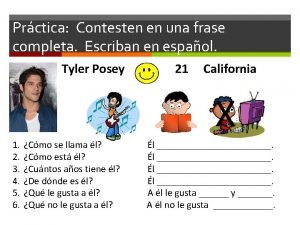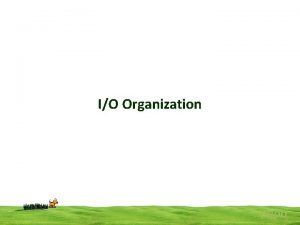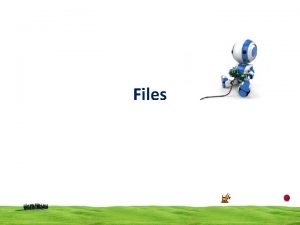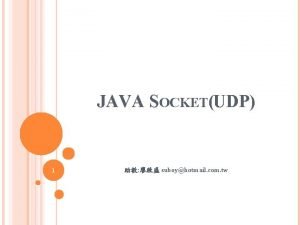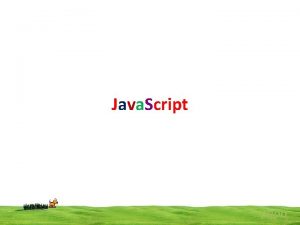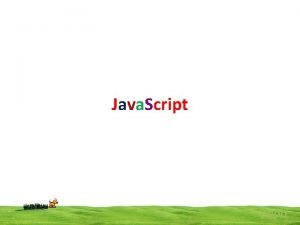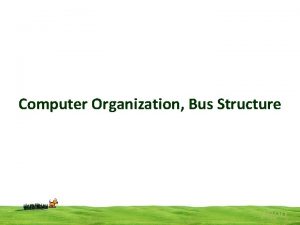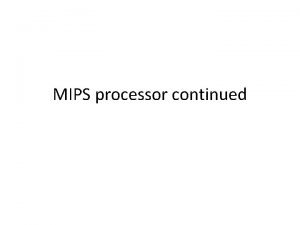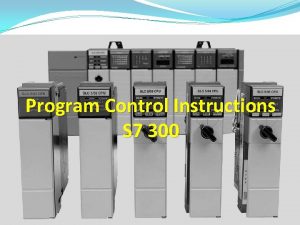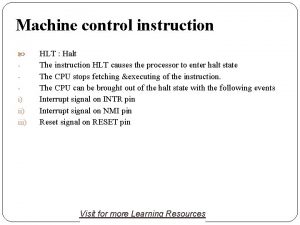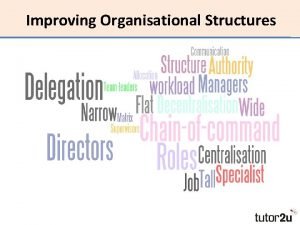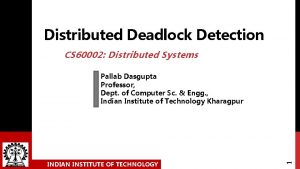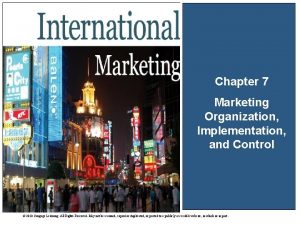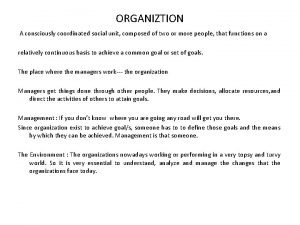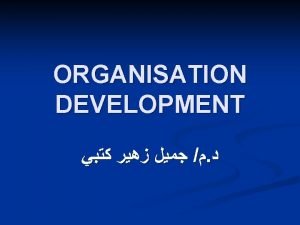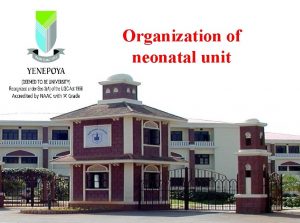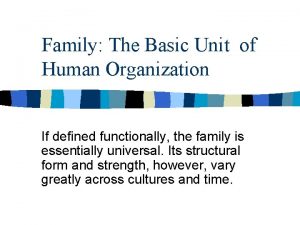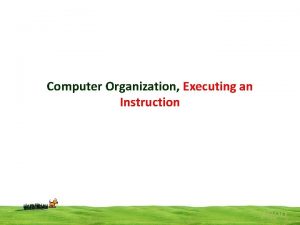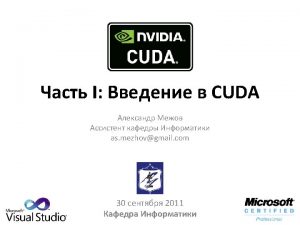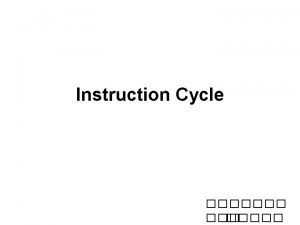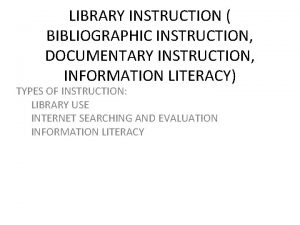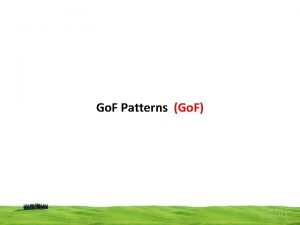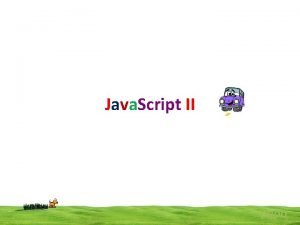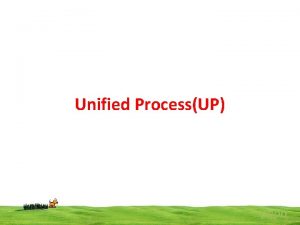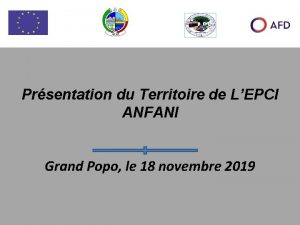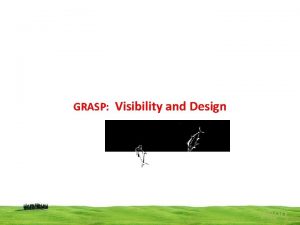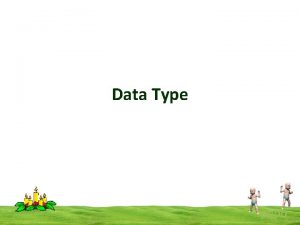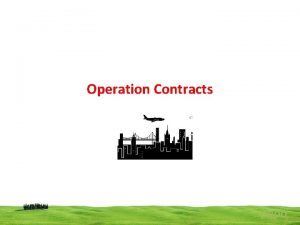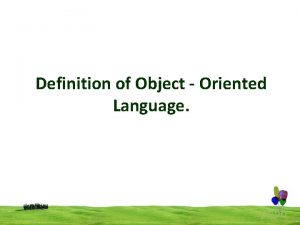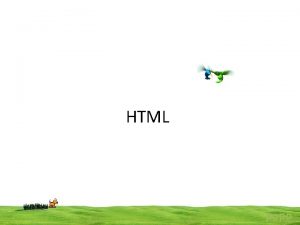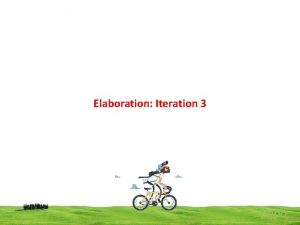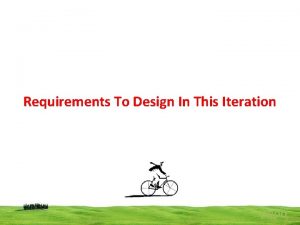CONTROL UNIT ORGANIZATION popo CONTROL UNIT ORGANIZATION Instruction































- Slides: 31

CONTROL UNIT ORGANIZATION popo

CONTROL UNIT ORGANIZATION • Instruction Execution • The CPU executes a sequence of instructions. • The execution of an instruction is organized as an instruction cycle: it is performed in several steps; • Each step is executed as a set of several micro operations. • The task performed by any micro operation falls in one of the following categories: • - Transfer data from one register to another; • - Transfer data from a register to an external interface (system bus); • - Transfer data from an external interface to a register; • - Perform an arithmetic or logic operation, using registers for input and output. popo

CONTROL UNIT ORGANIZATION • Instruction Execution popo

CONTROL UNIT ORGANIZATION • Microoperations and Control Signals • In order to allow the execution of a microoperation, one or several control signals have to be issued • Examples: • a) signals for transferring content of register R 0 to R 1: • R 0 out, R 1 in • b) signals for adding content of Y to that of R 0 (result in Z): • R 0 out, Add, Zin • The CPU executes an instruction as a sequence of control steps. popo

CONTROL UNIT ORGANIZATION • Microoperations and Control Signals • Instruction: • Add (R 3), R 1 popo

CONTROL UNIT ORGANIZATION • The first (three) control steps are identical for each instruction; they perform instruction fetch and increment the PC. • The following steps depend on the actual instruction (stored in the IR). • If a control step issues a read, the value will be available in the MDR after one additional step. • Several micro operations can be performed in the same control step if they don’t conflict • (for example, only one of them is allowed to output on the bus) popo

CONTROL UNIT ORGANIZATION • Control Unit • The basic task of the control unit : • - For each instruction the control unit causes the CPU to go through a sequence of control steps; • - in each control step the control unit issues a set of signals • The control unit is driven by the processor clock. • The signals to be generated at a certain moment depend on: • - the actual step to be executed; • - the condition and status flags of the processor; • - the actual instruction executed; • - external signals received on the system bus (e. g. interrupt signal) popo

CONTROL UNIT ORGANIZATION popo

CONTROL UNIT ORGANIZATION • To execute instructions, the processor must have some means of generating the control signals needed in the proper sequence. • Three Techniques : • Hardwired control , • Microprogrammed control and • PLA control • Hardwired system can operate at high speed; but with little flexibility.

Hardwired control • Each step in the sequence of execution is completed in one clock period • A counter is used to keep track of the control steps • The control signals are determined by the following information • Contents of the control step counter • Contents of the instruction register • Contents of the condition code flags • External input signal, such as MFC and interrupt requests

Control Unit Organization Clock CLK Control step counter External inputs IR Decoder/ encoder Condition codes Control signals Figure 7. 10. Control unit organization.

Detailed Block Description

Hardwired control • The step decoder provides a separate signal line for each step or time slot in the control sequence • The output of the instruction decoder consists of separate line for each machine instruction. • For any instruction loaded in the IR one of the output line INS 1 through INSm is set 1 • All other lines are set 0 • Input signal to the decoder are combined to generate the individual control signals Yin, Pcout, ADD End So on

Hardwired control • An example of how the encoder generates the Zin control signal for the processor organization show below • Implementation of the logic function • Zin = T 1 + T 6 • ADD + T 4 • BR + … • this signal is asserted during time slot T 1 for all instructions • During T 6 for an Add instruction • During T 4 for an unconditional branch instruction and so on

Generating Zin • Zin = T 1 + T 6 • ADD + T 4 • BR + … Branch T 4 Add T 6 T 1 Figure 7. 12. Generation of the Zin control signal for the processor in Figure 7. 1.

Hardwired control • Another example shown below • A circuit that generate the End control signal from the logic function • End = T 7 • ADD + T 5 • BR + (T 5 • N + T 4 • N) • BRN +…

Generating End • End = T 7 • ADD + T 5 • BR + (T 5 • N + T 4 • N) • BRN +…

Hardwired control • The End instruction starts a new instruction fetch cycle by resetting the control signal step counter to its starting value • The RUN set to 1 causes the counter to be incremented by one at the end of every clock cycle • When RUN=0 the counter stops counting • It is needed when ever WMFC signal is issued, the processor to wait the reply from memory

Microprogrammed Control

Microprogrammed Control • Control signals are generated by a program similar to machine language programs. • Control Word (CW); micro routine; microinstruction

Microprogrammed Control

Micro programmed Control • Control word: (CW)- is a word whose individual bits represent the various control signal • Each control steps in the control sequence defines a unique combinations of 0 s and 1 s in the CW • Select Y is represented by select =0 • Select 4 by select 1 • Micro routine : Collection of CW to a machine instructions • Micro instruction : Each control word

Overview • Control store One function cannot be carried out by this simple organization.

Micro programmed Control • The micro routines for all instructions are stored in a special memory called control store • The control unit can generate signals by sequentially reading CWs from the control store • To read Cws sequentially from control word a micro program counter (μPC) is used • Every time a new instruction is loaded in the IR • Then μPC automatically incremented by the clock • Thus the control signal are generated various parts of the processor

PLA Control • Programmable logic array PLA • PLA is LSI device that can implemented any complex combinational circuits • It is used to reduce the number of Ics and the no of interconnection wires

PLA Control

PLA Control • An external sequence register establishes the present state of the control circuit • The PLA output determine which • 1) Micro operations should be initiated, • 2) Depending on the external input conditions • 3) The present state of sequence register • At the same time other PLA outputs determine the next state of the sequence register • Unwanted connections are "blown"

CONTROL UNIT ORGANIZATION popo

PLA • • • n Input Lines AND Array • • • PLA OR Array • • • K Word Lines m Output Lines

Internal Structure of PLA Inputs A B A’ C B’ C’ OR ARRAY A’B’ AC’ B BC’ AC AND ARRAY F 0 F 1 F 2 Outputs F 3

CONTROL UNIT ORGANIZATION popo
 Frase completa
Frase completa Popo io
Popo io Stream is a sequence of bytes
Stream is a sequence of bytes Popo
Popo Www.popo.tw port 80
Www.popo.tw port 80 Js popo
Js popo Js popo
Js popo Bus structure in computer organization
Bus structure in computer organization Individualized instruction vs differentiated instruction
Individualized instruction vs differentiated instruction Direct vs indirect instruction
Direct vs indirect instruction Instruction set architecture in computer organization
Instruction set architecture in computer organization Mips control signals
Mips control signals Program control instruction
Program control instruction Hlt instruction example
Hlt instruction example Process organization in computer organization
Process organization in computer organization Point by point organization example
Point by point organization example Unit 6 review questions
Unit 6 review questions Types of span of control in organization
Types of span of control in organization Control organization for distributed deadlock detection
Control organization for distributed deadlock detection Marketing organization implementation and control
Marketing organization implementation and control Consciously coordinated
Consciously coordinated Organisation as a social unit
Organisation as a social unit Lesson 4 levels of development
Lesson 4 levels of development Organization of neonatal unit
Organization of neonatal unit Basic unit of organization in society
Basic unit of organization in society Translational research institute on pain in later life
Translational research institute on pain in later life Distinguish between process control and product control
Distinguish between process control and product control Control volume vs control surface
Control volume vs control surface Stock control e flow control
Stock control e flow control Control volume vs control surface
Control volume vs control surface Negative regulation
Negative regulation What is variable in research
What is variable in research
